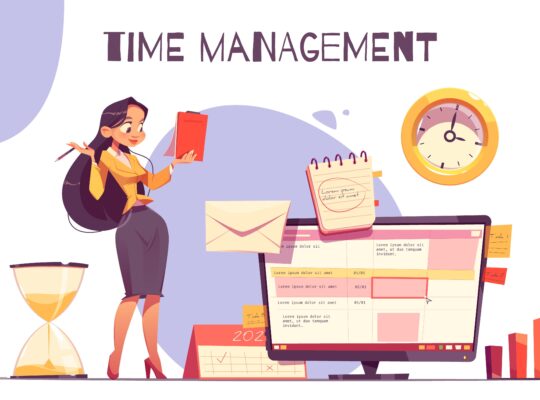| Time Management for Busy People | ||
| Instructor: Samantha Bennett and Madecraft | ||
| Released: 11/18/2020 | Course Details 50m Beginner | |
| Skills Covered Time Management | Course Link | |
| Professional Certifications and Continuing Education Units (CEUs) N/A | ||
| How are you doing at getting things done? If you’re like most people, you’ve tried traditional time management, you’ve read the books—but it didn’t stick, right? In this course, Sam Bennett shares how to take control of your calendar to get things completed and checked off your lists. Learn how to master your to-do list, schedule effectively, and assess your progress. Plus, Sam shares advanced time-management strategies you can implement today, including how to reverse engineer your time. This course was created by Madecraft. We are pleased to host this training in our library. Source: LinkedIN Learning | ||
What’s Wrong With Your List
4-7-8 breathing
Staying focused, calm and proactive will have a positive ripple effect.
Inhale for a count of four, hold for a count of seven and exhale for a count of eight. Do that three times.
You don’t get bonus points for being busy
You don’t get bonus points for being busy, you get bonus points for being effective.
Before accepting someone’s asks of you, say “let me check my schedule and get back to you.” If you can’t complete the task, simply say “Thank you for thinking of me. I’m sorry, I’m not available.” Most of the time, the person won’t ask you why or push you on it because they know that you thought about it.
Give yourself space to make decisions without peer pressure.
Activity is not the same as action
Being busy is the same as being effective.
Dedicate at least 15 minutes per day to moving your dreams forward. Plan to take action and schedule the time.
The end of overwhelm
Overwhelm happens when everything is “urgent”.
Two easy strategies:
- Turn off alerts and notifications.
- Be decisive and speedy.
10-10-10 Rule
- Will this matter in 10 minutes?
- Will this matter in 10 months?
- Will this matter in 10 years?
How will I feel about this decision in 10 minutes, 10 months and 10 years? What is the long-term effect of this activity or option that I have in front of me?
Your could-do list
Write your ideas down on paper – all one million of them.
One problem with to-do lists is that we tend to only write down the things that we know we “can do” or “will do” as opposed to writing down the things that we “could do”.
Make a “Could-Do” List. Put one bold idea on your could-do list.
Mastering Your List
Give your item a groovy name
Get creative and give your tasks an inspiring name.
Rename:
- Revise my manuscript -> Polish the diamonds of my words
- Update my resume -> Put all the trophies in the case
- Clear off table -> Project Dinner Party!
This renaming strategy is actually a reframing strategy and giving a project a name that reminds you of your values of why behind your project will help keep you motivated.
Reframe how you look at your old tasks.
Time guesstimate
If you can’t estimate the time frame, your project is too big.
The great thing about guesstimating how much time something’s going to take is that it allows you to plan and prioritize your day. It also helps you find little nooks and crannies in the day. Sometimes if you only have 20 minutes before your next meeting, you can look at the list and see something that only takes 10 minutes, take care of it right now and keep chipping away at the items that way.
Estimating timing helps you with time management.
Money guesstimate
Prioritize big payoffs and worthwhile investments. Focus on the money-maker tasks if you want to make money.
Inclination guesstimate
How inclined am I to do this actual task right now? How much do I feel like actually doing the actual thing?
Benefit:
- It takes into account desire.
- Recognize what motivates you – your 10’s.
- Recognize what fatigues you – too many 1’s, 2’s, 3’s and 4’s.
Moment of Honesty
- Do I really want to do this?
- Do I really have to do it?
- Is now really the right time?
Look at your to-do list and mark your desire for each task.
The beauty of a good could-do list
Change your to do list, change your life!
Scheduling
The problem with most planners
Online calendars are too impersonal, and they lack an ability to personalize. Schedule your day in a way that makes the most sense for you.
Change your planner and change your life
Make the time and schedule whatever you want to accomplish. We earn the respect of others by keeping promises to them. We create self respect by keeping promises to ourselves.
Track everything you want to achieve in one planner.
- Reduce overwhelm
- Increase productivity
- Clarify your time and energy
Eliminate emergencies
Idea -> Invitation -> Toleration -> EMERGENCY!
It starts by having a little idea about something. When you start thinking about the idea, you get invitations about that idea. When you ignore progress, you tolerate minor issues. When left unattended, minor issues can become major issues. Take action early to prevent emergencies from springing up.
End-of-Week Assessment
The key to happiness
Use your planner to track your progress. People are able to make progress because they are tracking that progress and having a daily reminder.
Daily tracking
- Encourages consistency
- Keep you on track
- Fosters positivity
Assessing what got done
One of the most underrated tools for good time management and to improve productivity is to perform a weekly self assessment. Write down five things you accomplished last week. Be proud of yourself. Acknowledging your success fuels motivation. Acknowledging your success fuels more success.
Assessing what you know now
Acknowledge the things that you’ve learned, either intentionally or unintentionally.
Rational vs. inner wisdom
What is your inner voice saying? What is overly critical? Let your inner wisdom guide you, not your inner critic.
Make 90-second art
Make 90-second art about your feelings. Noone will ever see it, so you don’t need to be an artist, just draw something! Feelings just want to be felt.
When you acknowledge your feelings, you can move past them.
Look at next week
You can accomplish big things without a lot of pressure. What are my “reach” goals? What’s a realistic timeline to achieve those? Each week, sit down and write down just three things you could do this next week to help you create a life that you are proud of.
More Strategies for Better Time Management
Reverse engineering your time
One way to make sure you stay on point is to reverse engineer your day. Start at the end and work backwards, allotting time for every step.
Reverse engineer large projects to ensure you have the time and resources.
Three strategies for your time management
- Do the most important task before you check your email.
- Keep your meetings to 20 minutes but schedule the hour in case the meeting goes longer and gives you time for bathroom breaks, follow-up on something urgent, etc.
- Schedule your day around your natural rhythms.
Three strategies for your team
- Encourage your team to not check emails first thing, instead do important tasks first.
- Schedule open office hours. Schedule distractions.
- Schedule “do not disturb” hours (door closed)
- No meeting over 90 minutes
- Schedule 20 minute meetings
- Start with positives
- Managing your team’s time helps you manage your own time.
Plan to fail
Foster a communicative work culture. Another way to help prevent disasters is to have mini deadlines along the way to the larger deadline. Set intermediate deadlines to check progress and keep projects on track. Under promise, over deliver, and plan to fail.
 | Remember! To experience the full benefit of this guide, I highly recommend you watch the full training session. |






